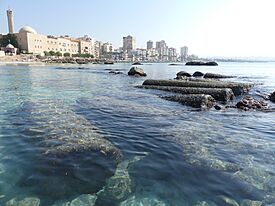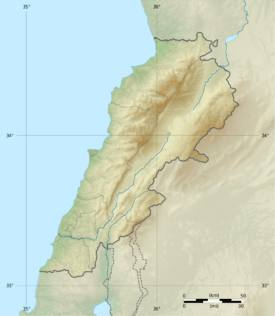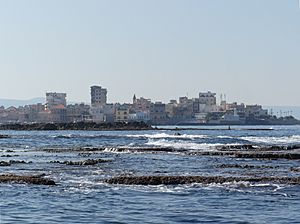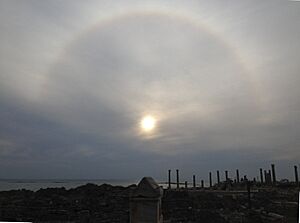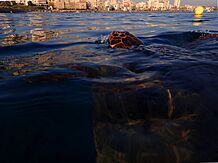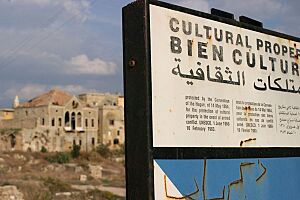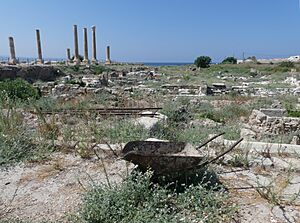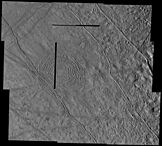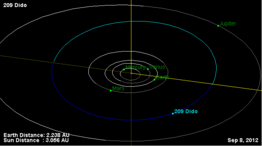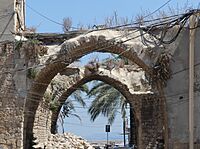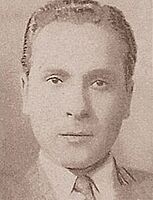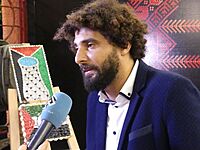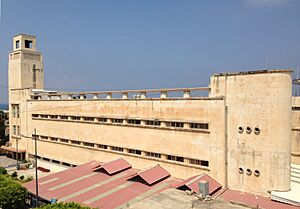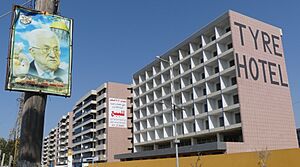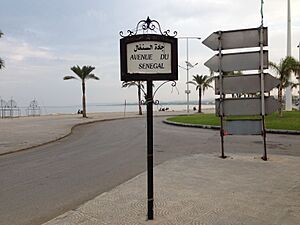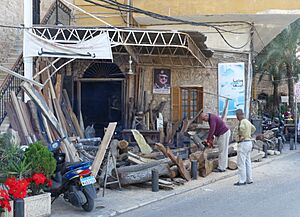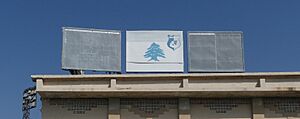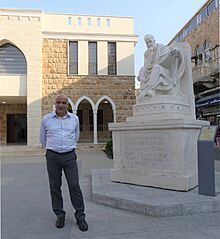Tyre, Lebanon facts for kids
Quick facts for kids
Tyre
صور
Tyr, Sur, Sour
|
|
|---|---|
|
City
|
|
| Arabic transcription(s) | |
| • Latin | Ṣūr |
|
The Egyptian harbour with the submerged ancient columns with the skyline of the modern city in the background, aerial view of Tyre.
|
|
| Country | |
| Governorate | South Governorate |
| District | Tyre |
| Municipalities | Abbassieh, Ain Baal, Borj Ech Chemali, Sour |
| Established | c. 2750 BCE |
| Area | |
| • City | 4 km2 (2 sq mi) |
| • Metro | 17 km2 (7 sq mi) |
| Population | |
| • City | 60,000 |
| • Density | 15,000/km2 (39,000/sq mi) |
| • Metro | 174,000 |
| Demonym(s) | Tyrian |
| Time zone | UTC+2 (EET) |
| • Summer (DST) | UTC+3 (EEST) |
| Type: | Cultural |
| Criteria: | iii, vi |
| Designated: | 1984 (8th session) |
| Reference #: | 299 |
Tyre (pronounced like "tire") is an ancient city in Lebanon. It is one of the oldest cities in the world where people have lived without stopping.
Tyre was a very important city for the Phoenician people long ago. Legends say it's the birthplace of famous figures like Europa, her brothers Cadmus and Phoenix, and Carthage's founder Dido (also known as Elissa). The city has many old sites, including the Tyre Hippodrome. Because of its rich history, the entire city was added to the UNESCO World Heritage Site list in 1984.
Today, Tyre is the fourth largest city in Lebanon. It is the main city of the Tyre District in the South Governorate. In 2016, about 200,000 people lived in the Tyre area. This includes many refugees, as Tyre hosts three Palestinian refugee camps in Lebanon: Burj El Shimali, El Buss, and Rashidieh.
Contents
Where is Tyre?
<mapframe latitude="33.28" longitude="35.239" zoom="11" width="220" height="200" align="right" />
Tyre is located on the coast of the Mediterranean Sea, about 80 km (50 mi) south of Beirut. It used to be two separate places: Tyre itself was on an island, and a nearby settlement called Ushu was on the mainland. Ushu was later called Palaetyrus, meaning "Old Tyre".
The island city was built on a rocky area, which is why its name "S‘r" in Phoenician means "rock". Tyre had two ports. The "Sidonian port" to the north is still partly there today. The "Egyptian port" to the south might have been found recently.
Throughout history, people in the Tyre area have benefited from lots of fresh water. This water comes from nearby springs like Rashidieh and Ras Al Ain. There are also springs to the north and the Litani River.
The modern city of Tyre covers much of the original island. It has also spread onto the causeway built by Alexander the Great in 332 BCE. This causeway, which connected the island to the mainland, became much wider over time due to sand building up. The part of the original island not covered by the modern city is now an important archaeological site.
Tyre's urban area is on a fertile coastal plain. This means that in 2017, about 44% of its land was used for farming within the city. Buildings covered over 40% of the land.
Tyre is near some major faults in the Earth's crust. It has had many strong earthquakes over thousands of years. However, the risk of earthquakes today is considered low to moderate. Tsunamis and landslides after earthquakes are bigger natural risks for the people of Tyre.
Scientists believe there are huge amounts of natural gas under the waters off Tyre's coast. However, getting this gas has been delayed by disagreements over borders.
What's in a Name?
The name "Tyre" comes from very old languages. In Akkadian, it was Ṣurru. In Phoenician, it was Ṣūr. In Hebrew, it was Ṣōr. In these languages, the name means 'rock'. This is because the city was first built on a rocky area.
The ancient Greek name was Týros, which is where the English name "Tyre" comes from. People from Tyre are called Tyrians.
Weather in Tyre
Tyre has a Hot-summer Mediterranean climate. This means it has six months of dry weather from May to October. On average, Tyre gets 300 sunny days a year. The average yearly temperature is 20.8°C.
The hottest month is August, with an average high of 30.8 °C. The coldest month is January, with an average low of 10 °C. Tyre gets about 645 mm of rain each year. The sea water temperature is lowest in February (17 °C) and highest in August (32 °C).
Unfortunately, rising sea levels due to global warming are a threat to Tyre's coast. This can cause coastal erosion, where the land wears away.
Tyre's Long History
The ancient city of Tyre is located on the coast of Phoenicia in modern Lebanon. People have lived here since the Bronze Age. Tyre became a very important Phoenician city-state between the 9th and 6th centuries BCE. It founded famous colonies around the Mediterranean Sea, like Carthage.
In 572 BCE, Persia took control of Tyre. Then, Alexander the Great conquered it in 332 BCE. The city has amazing ancient ruins from the Hellenistic, Roman, Byzantine, and Medieval times. These ruins are why Tyre was added to the UNESCO World Heritage list in 1984.
The Roman historian Justin wrote that Tyre's first people came from the nearby city of Sidon. They were looking for a new harbor. The Greek historian Herodotus visited Tyre around 450 BCE. He wrote that the city was founded 2300 years earlier (around 2750 BCE) as a walled city on the mainland, known as Paleotyre (Old Tyre).
The Phoenician people of Tyre were great traders. They used two harbors. The northern harbor, called the "Sidonian Harbour," is still partly used today. The southern harbor, called the "Egyptian Harbour," faced Egypt. Recent underwater digs have found parts of these ancient harbors.
A major event in Tyre's history was when Alexander the Great built a causeway to reach and conquer the island city in 332 BCE. This causeway was about 750 meters long and 60 meters wide. It was built over a shallow sandbank. Over the centuries, this causeway grew wider as sand piled up. By Roman times, it had become a wide sandy strip, connecting the island to the mainland. This completely changed the city's shape and how it developed.
Tyre Coast Nature Reserve
Tyre is known for having some of Lebanon's cleanest beaches and waters. However, there is still some pollution from wastewater and trash, especially near the port.
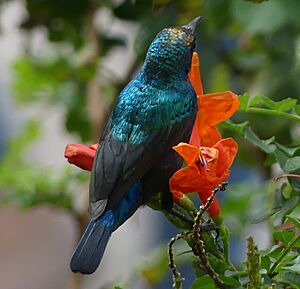
The Tyre Coast Nature Reserve (TCNR) was created in 1998. It is 3.5 km (2.2 mi) long and covers over 380 hectares (940 acres). This reserve is one of the best-preserved sandy coastlines in southern Lebanon. It has two main parts:
- A 1.8 km long sandy beach, which includes a public beach area and a special conservation zone for sea turtles and migrating birds.
- A 2 km stretch with small family farms and the springs of Ras El Ain.
The conservation zone is a safe place for migratory birds and endangered Loggerhead and green sea turtles to nest. Many other animals live here too, like the Arabian spiny mouse and European badger. Dolphins are often seen in the waters off Tyre.
The TCNR is very important for its diverse flora (plants) and fauna (animals). It has 275 different plant species. It is also home to seven species that are threatened, four that are found only here, and ten that are rare. Many plants used for medicine also grow here.
However, the reserve's plants and animals are facing threats. Some animal populations, like the caspian terrapin and green toad, are decreasing. Also, a plant called camphorweed has spread into the reserve from other areas.
Tyre's Historical Treasures
The ancient languages of Syriac and Akkadian have influenced the Arabic spoken in Tyre. For example, the word "Ba'ali," used for rain-fed vegetables, comes from the ancient Baal religion. The town of Ain Baal is also named after this Phoenician god.
The most visible parts of Tyre's ancient history are its archaeological sites. The first digs were done by Ernest Renan in the 1860s. Later, in the 1930s, Antoine Poidebard used aerial surveys and diving to explore the sites.
Large-scale excavations began in 1946 under Emir Maurice Chéhab. His teams uncovered many ruins at the Al Bass/Hippodrome and the City Site/Roman baths. In the 1960s, Honor Frost, a pioneer in underwater archaeology, explored Tyre's ancient harbor facilities.
Archaeological work stopped during the Civil War in 1975, and many records were lost. In 1984, UNESCO declared Tyre a World Heritage Site to protect its ruins from conflict and uncontrolled building.
Regular excavations started again in 1995. An Israeli bomb in 1995 uncovered an early church, possibly the Cathedral of Paulinus from 315 CE. In 1997, the first Phoenician cremation cemetery was found.
Threats to Tyre's ancient sites include new construction and the illegal trade of ancient artifacts. A planned highway could affect archaeologically sensitive areas. Also, a 2018 study found that Tyre's City site is at high risk of coastal erosion due to climate change.
Some historical buildings from the Ottoman period, like Khan Rabu, have fallen into ruin because they were not maintained.
In 2013, a group called the International Association to Save Tyre (IAST) held an online raffle with Sotheby's. They sold tickets to win a painting by Pablo Picasso to raise money for an artisans' village near Tyre. The raffle raised over $5 million.
Tyre in the Bible

The city of Tyre is mentioned many times in the Bible:
Old Testament
- The Tribe of Asher was given "the fortified city of Tyre" in Joshua 19.
- King Hiram I of Tyre helped David and Solomon build the royal palace and the Temple in Jerusalem. He provided architects, workers, cedar wood, and gold.
- Tyre is mentioned in the Book of Isaiah as being forgotten for 70 years after its "fortress is destroyed."
- The Book of Joel says that Tyre, Sidon, and Philistia sold people from Judah and Jerusalem to the Greeks, and they would be punished for it.
- Tyre is also mentioned in the Book of Ezekiel, Book of Amos, the Psalms, and the Book of Zechariah, which predicted its destruction.
New Testament
- Jesus visited the region of Tyre and Sidon. Many people from this area came to hear him preach.
- The Book of Acts says that Herod was angry with the people of Tyre and Sidon. He gave a public speech, but God struck him down because he took praise for himself.
- The same book describes Paul's journey to Tyre, where he stayed for seven days.
- In the Book of Revelation, chapter 18 talks about Tyre's trading wealth, similar to descriptions in Ezekiel.
Other Famous Writings
- Apollonius of Tyre is an old story that was very popular in the Middle Ages.
- Pericles, Prince of Tyre is a play partly written by William Shakespeare.
- In the 19th century, writers like John Ruskin and Rudyard Kipling used Tyre as an example of how even great powers can fall.
- The French comic book artist Albert Uderzo wrote Asterix and the Black Gold in 1981. It describes Asterix and Obelix traveling to the Middle East, where the Romans close the ports of Tyre to stop them.
- In 2015, the French Lebanese artist Joseph Safieddine published Yallah Bye, a graphic novel about his family's experience during the 2006 war in Tyre.
Space Objects Named After Tyre
- A large impact crater on Europa, one of Jupiter's moons, is named after Tyre. It's called "Tyre Macula" and is about 140 kilometers wide. Scientists think it was formed when an asteroid or comet hit Europa's ice surface.
- The main-belt asteroid 209 Dido is named after Dido, the legendary princess from Tyre who founded Carthage. It was discovered in 1879.
Culture and Arts
The first cinema in Tyre opened in the late 1930s. A fisherman named Hamid Istanbouli, who was also a traditional storyteller, started showing films on the wall of a Turkish bathhouse. Soon, more cinemas opened, like the Roxy in 1939 and the Empire in 1942.
By the mid-1950s, Tyre had four cinemas, and four more opened nearby. These cinemas were important community places. They hosted live shows by famous actors and musicians, bringing people together. The "Cinema Rivoli of Tyre," which opened in 1959, became one of the country's top movie theaters.
Two artists from Tyre greatly influenced Lebanese music: Halim el-Roumi (1919–1983) and Ghazi Kahwaji (1945–2017). Halim el-Roumi is said to have discovered the famous singer Fairuz. Ghazi Kahwaji was Lebanon's first scenographer (someone who designs stage sets) and worked for the Rahbani brothers and Fairuz for 30 years.
However, cultural life in Tyre was badly affected by armed conflicts. Cinemas were damaged and eventually closed.
In the mid-1990s, the idea of a Tyre International Festival was brought back. It is now held every year at the ancient Roman hippodrome. Famous international artists like Elton John and Sarah Brightman have performed there, along with Lebanese stars.
In 2006, Tyre's municipality opened the "Centre de Lecture et d’Animation Culturelle" (C.L.A.C.), the city's first public library.
In 2014, an organization called Tiro Association for Arts restored the old Al Hamra cinema. It is now run by Kassem Istanbouli, whose grandfather was one of the first cinema owners in Tyre. In 2018, his group also restored the Rivoli Cinema, turning it into the non-commercial Lebanese National Theater. This theater is a free cultural space that trains children and young people in arts. They also have a "Mobile Peace Bus" that promotes arts in nearby villages.
Learning in Tyre
Tyre has several important schools and universities.
The Jafariya School was founded in 1938. It grew with donations and became the first Secondary School in Southern Lebanon in 1946. It is still one of Tyre's main schools.
The charity organization of Imam Musa al-Sadr plays a big role in education. It runs Orphanages, adult education, and vocational training programs, especially for young women.
The Islamic University of Lebanon (IUL) opened a branch in Tyre in 1996.
The Lebanese Evangelical School in Tyre is one of the largest schools in the city, with a history of over 150 years. Other private schools include Collège Élite and Cadmous College. Cadmous College has about 10% Christian and 90% Muslim students.
In 2019, 17-year-old Ismail Ajjawi, a Palestinian resident of Tyre, made headlines. He earned a scholarship to Harvard but was initially denied entry to the U.S. He was later allowed to start his studies.
People of Tyre
It's hard to get exact population numbers for Tyre because the Lebanese government only gives estimates. However, in 2016, it was estimated that 201,208 people lived in Tyre, including many refugees.
Most Lebanese people in Tyre are Shia Muslim, but there is also a small Christian community. In 2010, about 15% of Tyre's population was Christian.
Tyre is home to over 60,000 Palestinian refugees. Most are Sunni Muslims, with some Christian families. These refugees live in camps like Al Buss, Burj El Shimali, and Rashidieh.
In recent years, the number of refugees from Syria and Palestinian refugees from Syria has increased in these camps. This has sometimes caused tension because new arrivals might work for lower wages.
Tyre is sometimes called "Little West Africa" because many families have relatives living in West African countries like Senegal, Sierra Leone, and Nigeria. Many immigrants in Senegal originally came from Tyre. One of Tyre's main streets is even called "Avenue du Senegal."
In 2016, it was estimated that about 43% of Lebanese people in the Tyre urban area live in poverty.
Tyre's Economy
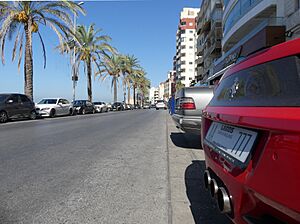
Tyre's economy mainly relies on tourism, construction, and money sent home by Tyrians living abroad, especially in West Africa.
The UNIFIL also helps Tyre's economy. Their members spend money in the city, and UNIFIL also supports local projects like road repairs.
In 2016, olive trees covered 38% of Tyre's agricultural land. Citrus fruits covered 25%, but 20% of the citrus harvest was wasted.
Tyre has one of Lebanon's major ports, though it's smaller than the ports in Beirut and Tripoli. After the 2020 Beirut explosion damaged the Port of Beirut, the government decided to use the Port of Tyre as a backup.
In the harbor, the Barbour family still builds wooden boats. Tyre is one of the few cities in the Mediterranean that keeps this ancient tradition alive. However, the boat-building business is struggling. In 2004, over 600 fishermen in Tyre were finding it hard to make enough money.
Land prices in Tyre grew by 4.4% between 2014 and 2018, the highest rate in the country. This increase is largely due to money sent from Tyrians living abroad.
There are also large amounts of natural gas off the coast of Tyre. A group of companies, including TotalEnergies and Eni, has been given permission to drill for it.
Sports in Tyre
Tadamon Sour Sporting Club, often called Tadamon (meaning "Solidarity"), is Tyre's oldest and most famous football club. It was founded in 1946. They play their home games at the Tyre Municipal Stadium. Tadamon has won one Lebanese FA Cup (2000–01) and two Lebanese Challenge Cups (2013 and 2018).
Their traditional rivals, Salam Sour Sports Club, are also based in Tyre.
In 2001, Tadamon SC lost its Lebanese Premier League championship title due to accusations of match-fixing.
That same year, a player from Tadamon's youth team, Roda Antar, was loaned to Germany's Hamburger SV. After playing in Germany and China for many years, he returned to Tadamon for his final season before retiring.
Several professional footballers from Tyre have played for the Lebanon national team, including Rabih Ataya and Nassar Nassar.
Sister Cities
Tyre is connected with these cities around the world:
Famous People from Tyre
- Hiram I, a king of Tyre mentioned in the Bible.
- Dido, the legendary founder of Carthage.
- Ulpian, a famous Roman lawyer from the 3rd century CE.
- Porphyry, a well-known philosopher and writer.
- William of Tyre, a historian and Archbishop in the 12th century.
- Musa al-Sadr, an important Shia leader.
- Rabab al-Sadr, an activist and sister of Musa al-Sadr.
- Halim el-Roumi, a famous singer and composer.
- Nabih Berri, a long-time political leader in Lebanon.
- As'ad AbuKhalil, a professor of political science.
- Joe Barza, a chef and TV personality.
- Rabih Ataya, Nassar Nassar, and Bilal Najdi, Lebanese football players.
Images for kids
See also
 In Spanish: Tiro para niños
In Spanish: Tiro para niños


